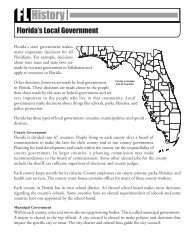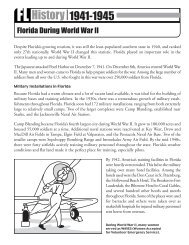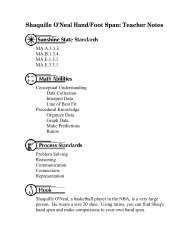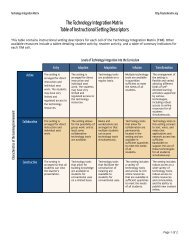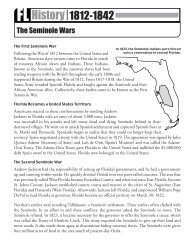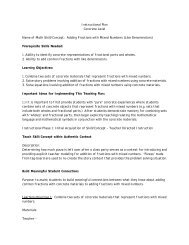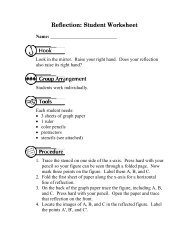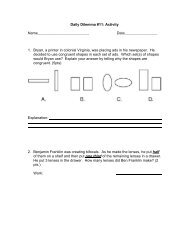Problem Solving Strategies
Problem Solving Strategies
Problem Solving Strategies
You also want an ePaper? Increase the reach of your titles
YUMPU automatically turns print PDFs into web optimized ePapers that Google loves.
The Accuracy of Fast Phylogenetic Methods for Large DatasetsLuay Nakhleh Bernard M.E. Moret Usman RoshanDept. of Computer Sciences Dept. of Computer Science Dept. of Computer SciencesUniversity of Texas University of New Mexico University of TexasAustin, TX 78712 Albuquerque, NM 87131 Austin, TX 78712Katherine St. John Jerry Sun Tandy WarnowLehman College and Dept. of Computer Sciences Dept. of Computer SciencesThe Graduate Center University of Texas University of TexasCity University of New York Austin, TX 78712 Austin, TX 78712New York, NY 10468Whole-genome phylogenetic studies require various sources of phylogenetic signals to produce anaccurate picture of the evolutionary history of a group of genomes. In particular, sequence-basedreconstruction will play an important role, especially in resolving more recent events. But usingsequences at the level of whole genomes means working with very large amounts of data—largenumbers of sequences—as well as large phylogenetic distances, so that reconstruction methodsmust be both fast and robust as well as accurate. We study the accuracy, convergence rate, andspeed of several fast reconstruction methods: neighbor-joining, Weighbor (a weighted version ofneighbor-joining), greedy parsimony, and a new phylogenetic reconstruction method based on diskcoveringand parsimony search (DCM-NJ+MP). Our study uses extensive simulations based onrandom birth-death trees, with controlled deviations from ultrametricity. We find that Weighbor,thanks to its sophisticated handling of probabilities, outperforms other methods for short sequences,while our new method is the best choice for sequence lengths above 100. For very large sequencelengths, all four methods have similar accuracy, so that the speed of neighbor-joining and greedyparsimony makes them the two methods of choice.1 IntroductionMost phylogenetic reconstruction methods are designed to be used on biomolecular(i.e., DNA, RNA, or amino-acid) sequences. With the advent of gene maps for manyorganisms and complete sequences for smaller genomes, whole-genome approachesto phylogeny reconstruction are now being investigated. In order to produce accuratereconstructions for large collections of taxa, we will most likely need to combine bothapproaches—each has drawbacks not shared by the other. Because whole genomeswill yield large numbers of sequences, the sequence-based algorithms will need tobe very fast if they are to run within reasonable time bounds. They will also have toaccommodate datasets that include very distant pairs of taxa. Many of the sequencebasedreconstruction methods used by biologists (maximum likelihood, parsimonysearch, or quartet puzzling) are very slow and unlikely to scale up to the size ofdata generated in whole-genome studies. Faster methods exist (such as the popularneighbor-joining method), but most suffer from accuracy problems, especially fordatasets that include distant pairs.
<strong>Problem</strong> <strong>Solving</strong> <strong>Strategies</strong>• Look for a patternExample: Find the sum of the first 100 even positive numbers.Solution:The sum of the first 1 even positive numbers is 2 or 1(1+1) = 1(2).The sum of the first 2 even positive numbers is 2 + 4 = 6 or 2(2+1) = 2(3).The sum of the first 3 even positive numbers is 2 + 4 + 6 = 12 or 3(3+1) = 3(4).The sum of the first 4 even positive numbers is 2 + 4 + 6 + 8 = 20 or 4(4+1) = 4(5).Look for a pattern:The sum of the first 100 even positive numbers is 2 + 4 + 6 + ... = ? or 100(100+1) =100(101) or 10,100.• Make an organized listExample: Find the median of the following test scores:73, 65, 82, 78, and 93.Solution: Make a list from smallest to largest:657378 Since 78 is the middle number, the median is 78.8293• Guess and checkExample: Which of the numbers 4, 5, or 6 is a solution to(n + 3)(n - 2) = 36?Solution: Substitute each number for “n” in the equation. Six is the solutionsince (6 + 3)(6 - 2) = 36.• Make a tableExample:Solution:How many diagonals does a 13-gon have?Make a table:Number of sides Number of diagonals3 04 25 56 97 148 20Look for a pattern. Hint: If n is the number of sides, thenn(n-3)/2 is the number of diagonals. Explain in words why thisworks. A 13-gon would have 13(13-3)/2 = 65 diagonals.
• Work backwardsExample:Fortune <strong>Problem</strong>: a man died and left the following instructionsfor his fortune, half to his wife; 1/7 of what was left went to his son;2/3 of what was left went to his butler; the man’s pet pig got theremaining $2000. How much money did the man leave behindaltogether?Solution: The pig received $2000.1/3 of ? = $2000? = $60006/7 of ? = $6000? = $70001/2 of ? = $7000? = $14,000• Use logical reasoningExample: At the Keep in Shape Club, 35 people swim, 24 play tennis, and27 jog. Of these people, 12 swim and play tennis, 19 play tennisand jog, and 13 jog and swim. Nine people do all three activities.How many members are there altogether?Solution: Hint: Draw a Venn Diagram with 3 intersecting circles.• Draw a diagramExample:Fortune <strong>Problem</strong>: a man died and left the following instructionsfor his fortune, half to his wife; 1/7 of what was left went to his son;2/3 of what was left went to his butler; the man’s pet pig got theremaining $2000. How much money did the man leave behindaltogether?
• Solve a simpler problemExample: In a delicatessen, it costs $2.49 for a half pound of sliced roastbeef. The person behind the counter slices 0.53 pound. Whatshould it cost?Solution: Try a simpler problem. How much would you pay if a half poundof sliced roast beef costs $2 and the person slices 3 pounds? If ahalf pound costs $2, then one pound would cost 2 x $2 or $4.Multiply by the number of pounds needed to get the total:3 x $4 = 12.Now try the original problem: If a half pound costs $2.49, then onepound would cost 2 x $2.49 or $4.98. Multiply by the number ofpounds needed to get the total: .53 x $4.98 = $2.6394 or $2.64.• Read the problem carefullyKnow the meaning of all words and symbols in the problem.Example: List the ten smallest positive composite numbers.Solution: Since positive means greater than 0 and a composite number isa number with more than two whole number factors, the solutionis 4, 6, 8, 9, 10, 12, 14, 15, 16, 18. For example, 4 has threefactors, 1, 2, and 4.Sort out information that is not needed.Example: Last year the Williams family joined a reading club. Mrs. Williamsread 20 books. Their son Jed read 12 books. Their daughterJosie read 14 books and their daughter Julie read 7 books. Howmany books did the children of Mr. and Mrs. Williams readaltogether?Solution: You do not need to know how many books Mrs. Williams hasread since the question is focusing on the children.Determine if there is enough information to solve the problem.Example: How many children do the Williams have?Solution: There is not enough information to solve the problem. You do notknow if Josie, Julie, and Jed are the only children.• Create problem solving journalsStudents record written responses to open-ended items such as those tested onFCAT in mathematics. Student identifies problem solving strategies.
<strong>Problem</strong> <strong>Solving</strong> <strong>Strategies</strong>• Look for a pattern• Make an organized list• Guess and Check• Make a table• Work backwards• Use logical reasoning• Draw a diagram• Solve a simpler problem• Read the problem carefully• Create problem solving journals



